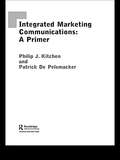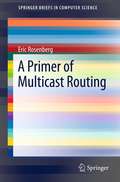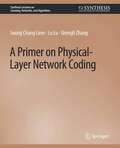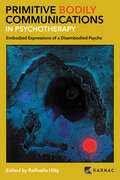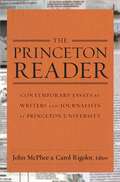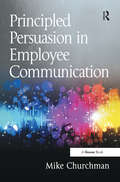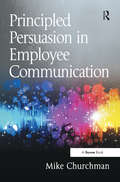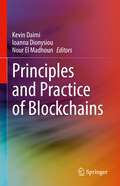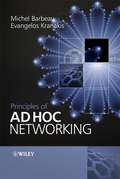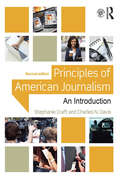- Table View
- List View
"Prime-Time" für die Wissenschaft?: Wissenschaftsberichterstattung in den Hauptfernsehnachrichten in Deutschland und Frankreich
by Katharina KowalewskiA Primer for Integrated Marketing Communications
by Philip Kitchen Patrick De PelsmackerThis textbook is the first introductory primer on integrated marketing communications. It combines theory and practice to show students of marketing how different aspects of integrated marketing communications (IMC) work together. Setting the scene in which IMC has emerged, the authors explain each component of the promotional mix and go on to explain the process of functional integration. The text includes key case studies on companies, including Proctor and Gamble, NSPCC and Ardi, illustrating the practical side of IMC in addition to an introduction to the main theories at work. Including an additional Study Guide at the back, this book will be a valuable resource for students of marketing and marketing communications.
A Primer for Integrated Marketing Communications
by Philip Kitchen Patrick De PelsmackerThis textbook is the first introductory primer on integrated marketing communications. It combines theory and practice to show students of marketing how different aspects of integrated marketing communications (IMC) work together. Setting the scene in which IMC has emerged, the authors explain each component of the promotional mix and go on to explain the process of functional integration. The text includes key case studies on companies, including Proctor and Gamble, NSPCC and Ardi, illustrating the practical side of IMC in addition to an introduction to the main theories at work. Including an additional Study Guide at the back, this book will be a valuable resource for students of marketing and marketing communications.
A Primer of Multicast Routing (SpringerBriefs in Computer Science)
by Eric RosenbergWhereas unicast routing determines a path from one source node to one destination node, multicast routing determines a path from one source to many destinations, or from many sources to many destinations. We survey multicast routing methods for when the set of destinations is static, and for when it is dynamic. While most of the methods we review are tree based, some non-tree methods are also discussed. We survey results on the shape of multicast trees, delay constrained multicast routing, aggregation of multicast traffic, inter-domain multicast, and multicast virtual private networks. We focus on basic algorithmic principles, and mathematical models, rather than implementation level protocol details. Many historically important methods, even if not currently used, are reviewed to give perspective on the evolution of multicast routing.
Primer on Client-Side Web Security (SpringerBriefs in Computer Science)
by Philippe De Ryck Lieven Desmet Frank Piessens Martin JohnsThis volume illustrates the continuous arms race between attackers and defenders of the Web ecosystem by discussing a wide variety of attacks. In the first part of the book, the foundation of the Web ecosystem is briefly recapped and discussed. Based on this model, the assets of the Web ecosystem are identified, and the set of capabilities an attacker may have are enumerated. In the second part, an overview of the web security vulnerability landscape is constructed. Included are selections of the most representative attack techniques reported in great detail. In addition to descriptions of the most common mitigation techniques, this primer also surveys the research and standardization activities related to each of the attack techniques, and gives insights into the prevalence of those very attacks. Moreover, the book provides practitioners a set of best practices to gradually improve the security of their web-enabled services. Primer on Client-Side Web Security expresses insights into the future of web application security. It points out the challenges of securing the Web platform, opportunities for future research, and trends toward improving Web security.
A Primer on Legal Reasoning
by Michael Evan GoldAfter years of teaching law courses to undergraduate, graduate, and law students, Michael Evan Gold has come to believe that the traditional way of teaching – analysis, explanation, and example – is superior to the Socratic Method for students at the outset of their studies.In courses taught Socratically, even the most gifted students can struggle, and many others are lost in a fog for months. Gold offers a meta approach to teaching legal reasoning, bringing the process of argumentation to the fore.Using examples both from the law and from daily life, Gold's book will help undergraduates and first-year law students to understand legal discourse. The book analyzes and illustrates the principles of legal reasoning, such as logical deduction, analogies and distinctions, and application of law to fact, and even solves the mystery of how to spot an issue.In Gold's experience, students who understand the principles of analytical thinking are able to understand arguments, to evaluate and reply to them, and ultimately to construct sound arguments of their own.
A Primer on Physical-Layer Network Coding (Synthesis Lectures on Learning, Networks, and Algorithms)
by Soung Liew Lu Lu Shengli ZhangThe concept of physical-layer network coding (PNC) was proposed in 2006 for application in wireless networks. Since then it has developed into a subfield of communications and networking with a wide following. This book is a primer on PNC. It is the outcome of a set of lecture notes for a course for beginning graduate students at The Chinese University of Hong Kong. The target audience is expected to have some prior background knowledge in communication theory and wireless communications, but not working knowledge at the research level. Indeed, a goal of this book/course is to allow the reader to gain a deeper appreciation of the various nuances of wireless communications and networking by focusing on problems arising from the study of PNC. Specifically, we introduce the tools and techniques needed to solve problems in PNC, and many of these tools and techniques are drawn from the more general disciplines of signal processing, communications, and networking: PNC is used as a pivot to learn about the fundamentals of signal processing techniques and wireless communications in general. We feel that such a problem-centric approach will give the reader a more in-depth understanding of these disciplines and allow him/her to see first-hand how the techniques of these disciplines can be applied to solve real research problems. As a primer, this book does not cover many advanced materials related to PNC. PNC is an active research field and many new results will no doubt be forthcoming in the near future. We believe that this book will provide a good contextual framework for the interpretation of these advanced results should the reader decide to probe further into the field of PNC.
Primitive Bodily Communications in Psychotherapy: Embodied Expressions of a Disembodied Psyche
by Raffaella HiltyEvery psychotherapist will be familiar with what it means to experience the hatred and despair of their most vulnerable patients in the midst of a psychotherapy session. Most often these patients will manage to express their feelings verbally, but what about those who never developed the capacity to speak? Or those who are capable of talking, but carry a complex range of unprocessed embodied feelings that cannot be verbally expressed? Some patients must rely on another type of language in order to communicate their dissociative states of mind. Primitive Bodily Communications explores how the ‘talking cure’ can still work when words fail and the body ‘talks.’ Non-verbal communication can be thought of as a form of body language and, even though this is a topic not frequently discussed, many practitioners have experienced working with people who communicate through the use of their bodies. The book does not refer to bodily communications as primitive because we see them as inferior to verbal language, but simply because they point to the beginnings of psychological development, to primary ways of being and relating, as well as to enduring aspects of ourselves. The contributors explore the topic of primitive bodily communications in the context of intellectual disability, eating disorders and bodily neglect, focusing on the communicative aspect of bodily expressions within the therapeutic relationship. A wide spectrum of clinical cases illustrates how these patients can reach a state of better physical and emotional containment and, when possible, of verbal communication.
The Princeton Reader: Contemporary Essays by Writers and Journalists at Princeton University
by John McPhee & Carol RigolotFrom a Swedish hotel made of ice to the enigma of UFOs, from a tragedy on Lake Minnetonka to the gold mine of cyberpornography, The Princeton Reader brings together more than 90 favorite essays by 75 distinguished writers. This collection of nonfiction pieces by journalists who have held the Ferris/McGraw/Robbins professorships at Princeton University offers a feast of ideas, emotions, and experiences--political and personal, light-hearted and comic, serious and controversial--for anyone to dip into, contemplate, and enjoy.The volume includes a plethora of topics from the environment, terrorism, education, sports, politics, and music to profiles of memorable figures and riveting stories of survival. These important essays reflect the high-quality work found in today's major newspapers, magazines, broadcast media, and websites. The book's contributors include such outstanding writers as Ken Armstrong of the Seattle Times; Jill Abramson, Jim Dwyer, and Walt Bogdanich of the New York Times; Evan Thomas of Newsweek; Joel Achenbach and Marc Fisher of the Washington Post; Nancy Gibbs of Time; and Jane Mayer, John McPhee, John Seabrook, and Alex Ross of the New Yorker.The perfect collection for anyone who enjoys compelling narratives, The Princeton Reader contains a depth and breadth of nonfiction that will inspire, provoke, and endure.
The Princeton Reader: Contemporary Essays by Writers and Journalists at Princeton University
by John McPhee Carol RigolotFrom a Swedish hotel made of ice to the enigma of UFOs, from a tragedy on Lake Minnetonka to the gold mine of cyberpornography, The Princeton Reader brings together more than 90 favorite essays by 75 distinguished writers. This collection of nonfiction pieces by journalists who have held the Ferris/McGraw/Robbins professorships at Princeton University offers a feast of ideas, emotions, and experiences--political and personal, light-hearted and comic, serious and controversial--for anyone to dip into, contemplate, and enjoy.The volume includes a plethora of topics from the environment, terrorism, education, sports, politics, and music to profiles of memorable figures and riveting stories of survival. These important essays reflect the high-quality work found in today's major newspapers, magazines, broadcast media, and websites. The book's contributors include such outstanding writers as Ken Armstrong of the Seattle Times; Jill Abramson, Jim Dwyer, and Walt Bogdanich of the New York Times; Evan Thomas of Newsweek; Joel Achenbach and Marc Fisher of the Washington Post; Nancy Gibbs of Time; and Jane Mayer, John McPhee, John Seabrook, and Alex Ross of the New Yorker.The perfect collection for anyone who enjoys compelling narratives, The Princeton Reader contains a depth and breadth of nonfiction that will inspire, provoke, and endure.
Principled Persuasion in Employee Communication
by Mike ChurchmanPrincipled Persuasion in Employee Communication highlights a new but significant dilemma for organisational leaders. Will they continue on the same track that, since the nineteenth century, has led them to exert increasing control over their employees? Or will they take another path, one that leads towards a new type of working environment where the culture encourages freedom of communication and movement? This book argues for an approach to employee communication that sets out to liberate employees from the stifling constraints that organisations continue to impose on them. Principled Persuasion is so-called because it uses persuasive techniques, based on clear principles, to create new, forward-looking organisational cultures. It sets out to increase employee happiness and minimise the harms done to employees at work. It grounds itself on a strong ethical base composed of fundamental, universal principles. It introduces a new approach to the use of language, not only calling for more clarity and meaning in organisational communication, but also for a more conscious use of rhetorical techniques to change vocabulary, metaphors and internal dialogue for the better. Make no mistake, most organisations have totally underrated the strategic importance of employee communication. Principled Persuaders understand that the key to dealing with the unpredictable events about to unfold in the twenty-first century will be a new way of communicating with the workforce. The flexibility, adaptability and innovation that will be needed to survive and prosper in coming decades can only be achieved by liberating employees, not imprisoning them further in established systems and processes.
Principled Persuasion in Employee Communication
by Mike ChurchmanPrincipled Persuasion in Employee Communication highlights a new but significant dilemma for organisational leaders. Will they continue on the same track that, since the nineteenth century, has led them to exert increasing control over their employees? Or will they take another path, one that leads towards a new type of working environment where the culture encourages freedom of communication and movement? This book argues for an approach to employee communication that sets out to liberate employees from the stifling constraints that organisations continue to impose on them. Principled Persuasion is so-called because it uses persuasive techniques, based on clear principles, to create new, forward-looking organisational cultures. It sets out to increase employee happiness and minimise the harms done to employees at work. It grounds itself on a strong ethical base composed of fundamental, universal principles. It introduces a new approach to the use of language, not only calling for more clarity and meaning in organisational communication, but also for a more conscious use of rhetorical techniques to change vocabulary, metaphors and internal dialogue for the better. Make no mistake, most organisations have totally underrated the strategic importance of employee communication. Principled Persuaders understand that the key to dealing with the unpredictable events about to unfold in the twenty-first century will be a new way of communicating with the workforce. The flexibility, adaptability and innovation that will be needed to survive and prosper in coming decades can only be achieved by liberating employees, not imprisoning them further in established systems and processes.
Principled Persuasion in Employee Communication
by Mike ChurchmanPrincipled Persuasion in Employee Communication highlights a new but significant dilemma for organisational leaders. Will they continue on the same track that, since the nineteenth century, has led them to exert increasing control over their employees? Or will they take another path, one that leads towards a new type of working environment where the culture encourages freedom of communication and movement? This book argues for an approach to employee communication that sets out to liberate employees from the stifling constraints that organisations continue to impose on them. Principled Persuasion is so-called because it uses persuasive techniques, based on clear principles, to create new, forward-looking organisational cultures. It sets out to increase employee happiness and minimise the harms done to employees at work. It grounds itself on a strong ethical base composed of fundamental, universal principles. It introduces a new approach to the use of language, not only calling for more clarity and meaning in organisational communication, but also for a more conscious use of rhetorical techniques to change vocabulary, metaphors and internal dialogue for the better. Make no mistake, most organisations have totally underrated the strategic importance of employee communication. Principled Persuaders understand that the key to dealing with the unpredictable events about to unfold in the twenty-first century will be a new way of communicating with the workforce. The flexibility, adaptability and innovation that will be needed to survive and prosper in coming decades can only be achieved by liberating employees, not imprisoning them further in established systems and processes.
Principled Persuasion in Employee Communication (PDF)
by Mike ChurchmanPrincipled Persuasion in Employee Communication highlights a new but significant dilemma for organisational leaders. Will they continue on the same track that, since the nineteenth century, has led them to exert increasing control over their employees? Or will they take another path, one that leads towards a new type of working environment where the culture encourages freedom of communication and movement? This book argues for an approach to employee communication that sets out to liberate employees from the stifling constraints that organisations continue to impose on them. Principled Persuasion is so-called because it uses persuasive techniques, based on clear principles, to create new, forward-looking organisational cultures. It sets out to increase employee happiness and minimise the harms done to employees at work. It grounds itself on a strong ethical base composed of fundamental, universal principles. It introduces a new approach to the use of language, not only calling for more clarity and meaning in organisational communication, but also for a more conscious use of rhetorical techniques to change vocabulary, metaphors and internal dialogue for the better. Make no mistake, most organisations have totally underrated the strategic importance of employee communication. Principled Persuaders understand that the key to dealing with the unpredictable events about to unfold in the twenty-first century will be a new way of communicating with the workforce. The flexibility, adaptability and innovation that will be needed to survive and prosper in coming decades can only be achieved by liberating employees, not imprisoning them further in established systems and processes.
Principled Selling: How to Win More Business Without Selling Your Soul (Kogan Page Ser.)
by David ToveyBecause buyer behaviour has changed and buyers now trust social media and personal recommendations more than salespeople, companies need to respond to this new reality to acquire customers. Principled Selling discusses the skills and behaviours needed to win customers, build relationships and retain existing ones. It offers a different, more effective approach based on the premise that if you want more sales, stop 'selling' and focus on building long-term, profitable relationships. Readers will learn to avoid cold calling and generate meetings; develop relationships built on trust to maintain customer loyalty; sell services in ways clients appreciate; sustain long-term sales growth and incorporate social media into an effective business development strategy.With a foreword from legendary sales expert and bestselling author Richard Denny, Principled Selling helps anyone involved in selling to align his or her techniques with customer expectations to get people to buy over and over again.
Principled Selling: How to Win More Business Without Selling Your Soul
by David ToveyBecause buyer behaviour has changed and buyers now trust social media and personal recommendations more than salespeople, companies need to respond to this new reality to acquire customers. Principled Selling discusses the skills and behaviours needed to win customers, build relationships and retain existing ones. It offers a different, more effective approach based on the premise that if you want more sales, stop 'selling' and focus on building long-term, profitable relationships. Readers will learn to avoid cold calling and generate meetings; develop relationships built on trust to maintain customer loyalty; sell services in ways clients appreciate; sustain long-term sales growth and incorporate social media into an effective business development strategy.With a foreword from legendary sales expert and bestselling author Richard Denny, Principled Selling helps anyone involved in selling to align his or her techniques with customer expectations to get people to buy over and over again.
Principles and Practice of Blockchains
by Kevin Daimi Ioanna Dionysiou Nour El MadhounThis book provides an essential compilation of relevant and cutting edge academic and industry work on key Blockchain topics. This book concentrates on a wide range of advances related to Blockchains which include, among others, Blockchain principles, architecture and concepts with emphasis on key and innovative theories, methodologies, schemes and technologies of Blockchain, Blockchain platforms and architecture, Blockchain protocols, sensors and devices for Blockchain, Blockchain foundations, and reliability analysis of Blockchain-based systems. Further, it provides a glimpse of future directions where cybersecurity applications are headed. The book is a rich collection of carefully selected and reviewed manuscripts written by diverse cybersecurity application experts in the listed fields and edited by prominent cybersecurity applications researchers and specialists.
Principles and Practice of Marketing (PDF)
by Jim BlytheWhen you think of marketing you may think of the adverts that pop up at the side of your screen or the billboards you see when you're out - all those moments in the day when somebody is trying to grab your attention and sell you something! Marketing is about advertising and communications in part, but it's also about many other things which all aim to create value for customers, from product research and innovation to after-care service and maintaining relationships. It's a rich and fascinating area of management waiting to be explored - so welcome to Marketing! Jim Blythe's Principles and Practice of Marketing will ease you into the complexities of Marketing to help you achieve success in your studies and get the best grade. It provides plenty of engaging real-life examples, including brands you know such as Netflix and PayPal - marketing is not just about products, but services too. Marketing changes as the world changes, and this textbook is here to help, keeping you up to speed on key topics such as digital technologies, globalization and being green The companion website offers a wealth of resources for both students and lecturers and is available at www. sagepub. co. uk/blythe3e. An electronic inspection copy is also available for instructors.
Principles and Practice of Marketing (PDF)
by Jim BlytheWhen you think of marketing you may think of the adverts that pop up at the side of your screen or the billboards you see when you're out - all those moments in the day when somebody is trying to grab your attention and sell you something! Marketing is about advertising and communications in part, but it's also about many other things which all aim to create value for customers, from product research and innovation to after-care service and maintaining relationships. It's a rich and fascinating area of management waiting to be explored - so welcome to Marketing! This friendly textbook will ease you into the complexities of Marketing to help you achieve success in your studies and get the best grade. It provides plenty of engaging real-life examples, including brands you know such as Netflix and PayPal - marketing is not just about products, but services too. Marketing changes as the world changes, and this textbook is here to help, keeping you up to speed on key topics such as digital technologies, globalization and being green. A supporting website includes lots of useful extra materials for your study such as videos and extra case studies to help make the text come alive - and more importantly, improve your chances of exam success and a career in marketing!.
Principles of Ad-hoc Networking
by Michel Barbeau Evangelos KranakisPrinciples of Ad Hoc Networking presents a systematic introduction to the fundamentals of ad hoc networks. An ad-hoc network is a small network, especially one with wireless or temporary plug-in connections. Typically, some of the network devices are part of the network only for the duration of a communications session or, in the case of mobile or portable devices, while in some close proximity to the rest of the network. These networks can range from small and static systems with constrained power resources to larger-scale dynamic and mobile environments. Wireless ad hoc networks facilitate numerous and diverse applications for establishing survivable dynamic systems in emergency and rescue operations, disaster relief and intelligent home settings. Principles of Ad Hoc Networking: Introduces the essential characteristics of ad hoc networks such as: physical layer, medium access control, Bluetooth discovery and network formation, wireless network programming and protocols. Explains the crucial components involved in ad-hoc networks in detail with numerous exercises to aid understanding. Offers key results and merges practical methodologies with mathematical considerations. Principles of Ad Hoc Networking will prove essential reading for graduate students in Computer Science, Electrical Engineering, Applied Mathematics and Physics as well as researchers in the field of ad hoc networking, professionals in wireless telecoms, and networking system developers. Check out www.scs.carleton.ca/~barbeau/pahn/index.htm for further reading, sample chapters, a bibliography and lecture slides!
Principles of American Journalism: An Introduction
by Stephanie Craft Charles N. DavisDesigned to engage, inspire and challenge students while laying out the fundamentals of the craft, Principles of American Journalism introduces readers to the core values of journalism and its singular role in a democracy. From the First Amendment to Facebook, the new and revised edition of this popular textbook provides a comprehensive exploration of the guiding principles of journalism and what makes it unique: the profession's ethical and legal foundations; its historical and modern precepts; the economic landscape of journalism; the relationships among journalism and other social institutions; the key issues and challenges that contemporary journalists face. Case studies, exercises, and an interactive companion website encourage critical thinking about journalism and its role in society, making students more mindful practitioners of journalism and more informed media consumers.
Principles of American Journalism: An Introduction
by Stephanie Craft Charles N. DavisDesigned to engage, inspire and challenge students while laying out the fundamentals of the craft, Principles of American Journalism introduces readers to the core values of journalism and its singular role in a democracy. From the First Amendment to Facebook, the new and revised edition of this popular textbook provides a comprehensive exploration of the guiding principles of journalism and what makes it unique: the profession's ethical and legal foundations; its historical and modern precepts; the economic landscape of journalism; the relationships among journalism and other social institutions; the key issues and challenges that contemporary journalists face. Case studies, exercises, and an interactive companion website encourage critical thinking about journalism and its role in society, making students more mindful practitioners of journalism and more informed media consumers.
Principles of American Journalism: An Introduction
by Stephanie Craft Charles N. DavisDesigned to engage, inspire, and challenge students while laying out the fundamentals of the craft, this textbook introduces readers to the core values of journalism and its singular role in a democracy. From the First Amendment to Facebook, this popular textbook – now in its third edition – provides a comprehensive exploration of the guiding principles of journalism and what makes it unique. Authors Stephanie Craft and Charles Davis cover the profession's ethical and legal foundations, its historical and modern precepts, the economic landscape of journalism, the relationships among journalism and other social institutions, and the key issues and challenges that contemporary journalists face. They also discuss the current ambiguities and transitions – economic and technological – occurring in the field, from nonprofit news sites to social media’s effects on journalism. Filled with relevant case studies, exercises, and discussion questions that encourage critical thinking about journalism and its role in society, this book helps students become better-informed media consumers as well as more mindful practitioners of journalism. The companion website features chapter-by-chapter flashcards, quizzes, and annotated weblinks for students and a separate instructor resource section that features sample test questions, PowerPoint slides, sample syllabi, and chapter-by-chapter activities and discussion questions.
Principles of American Journalism: An Introduction
by Stephanie Craft Charles N. DavisDesigned to engage, inspire, and challenge students while laying out the fundamentals of the craft, this textbook introduces readers to the core values of journalism and its singular role in a democracy. From the First Amendment to Facebook, this popular textbook – now in its third edition – provides a comprehensive exploration of the guiding principles of journalism and what makes it unique. Authors Stephanie Craft and Charles Davis cover the profession's ethical and legal foundations, its historical and modern precepts, the economic landscape of journalism, the relationships among journalism and other social institutions, and the key issues and challenges that contemporary journalists face. They also discuss the current ambiguities and transitions – economic and technological – occurring in the field, from nonprofit news sites to social media’s effects on journalism. Filled with relevant case studies, exercises, and discussion questions that encourage critical thinking about journalism and its role in society, this book helps students become better-informed media consumers as well as more mindful practitioners of journalism. The companion website features chapter-by-chapter flashcards, quizzes, and annotated weblinks for students and a separate instructor resource section that features sample test questions, PowerPoint slides, sample syllabi, and chapter-by-chapter activities and discussion questions.
Principles of Broadband Switching and Networking (Wiley Series in Telecommunications and Signal Processing #32)
by Soung C. Liew Tony T. LeeAn authoritative introduction to the roles of switching and transmission in broadband integrated services networks Principles of Broadband Switching and Networking explains the design and analysis of switch architectures suitable for broadband integrated services networks, emphasizing packet-switched interconnection networks with distributed routing algorithms. The text examines the mathematical properties of these networks, rather than specific implementation technologies. Although the pedagogical explanations in this book are in the context of switches, many of the fundamental principles are relevant to other communication networks with regular topologies. After explaining the concept of the modern broadband integrated services network and why it is necessary in today’s society, the book moves on to basic switch design principles, discussing two types of circuit switch design—space domain and time domain—and packet switch design. Throughput improvements are illustrated by some switch design variations such as Speedup principle, Channel-Grouping principle, Knockout principle, and Dilation principle. Moving seamlessly into advanced switch design principles, the book covers switch scalability, switch design for multicasting, and path switching. Then the focus moves to broadband communications networks that make use of such switches. Readers receive a detailed introduction on how to allocate network resources and control traffic to satisfy the quality of service requirements of network users and to maximize network usage. As an epilogue, the text shows how transmission noise and packet contention have similar characteristics and can be tamed by comparable means to achieve reliable communication. Principles of Broadband Switching and Networking is written for senior undergraduate and first-year postgraduate students with a solid background in probability theory.

